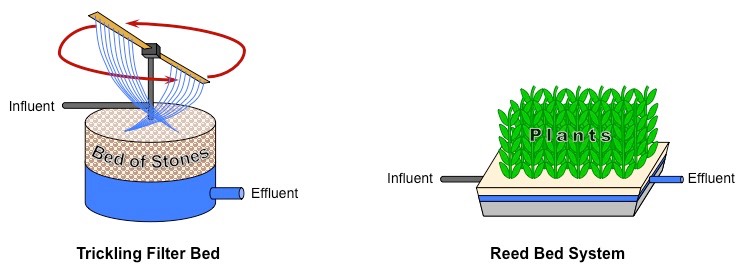F.2.1 List the roles of microbes in ecosystems, including producers, nitrogen fixers and decomposers
Producers: Change inorganic molecules into organic molecules that can be used as food by all other organisms in the environment
Nitrogen fixers: Remove nitrogen from the atmosphere and converts it into nitrates which can be used by the producers
Decomposers: Break down organic material, then release inorganic components from the organic matter into the environment
F.2.2 Draw and label a diagram of the nitrogen cycle

F.2.3 State the roles of Rhizobium, Azotobacter, Nitrosomonas, Nitrobacter and Pseudomonas denitrificans in the nitrogen cycle
Nitrogen fixation:
- Rhizobium is found in the root nodules of certain leguminous plants and fixes nitrogen gas into ammonia for its host (mutualistic nitrogen fixation)
- Azotobacter is found living freely in the soil and also fixes nitrogen, but without the need of a host (free-living nitrogen fixation)
Nitrification:
- Nitrosomonas is able to convert ammonium (NH4+) into nitrites (NO2–)
- Nitrobacter is able to convert the nitrites (NO2–) into nitrates (NO3–), which can then be absorbed by plant roots via active transport
Denitrification:
- Pseudomonas denitrificans is able to convert nitrites (NO2–) and nitrates (NO3–) into nitrogen gas (N2), which can return to the atmosphere
F.2.4 Outline the conditions that favour denitrification and nitrification
Nitrification is the biological oxidation of ammonia to produce nitrate ions (via the intermediate production of nitrites)
Denitrification is the biological process of nitrate reduction to produce molecular nitrogen (N2)
These processes occur best under the following conditions:

F.2.5 Explain the consequences of releasing raw sewage and nitrate fertiliser into rivers
Raw sewage contains organic matter, and together with nitrate fertilisers will increase the levels of nitrates and phosphates in rivers
Eutrophication is the ecosystem response to the addition of such substances to an aquatic system and will include:
- Algal blooms (in response to increased nutrient levels) and a subsequent spike in numbers of bacteria and microbes that feed on dead algae
- An increase in biochemical oxygen demand (BOD) by the saprotrophic bacteria results in deoxygenation of the water supply (reduced dissolved O2)
- The death or emigration of oxygen sensitive organisms and the proliferation of pollution tolerant organisms reduces biodiversity
- Increasing levels of toxins and heavy metals, along with greater numbers of pathogens, contaminating bathing and drinking water
- Decreasing water transparency (increased turbidity) may stress photosynthetic organisms, affecting food chains
F.2.6 Outline the role of saprotrophic bacteria in the treatment of sewage using trickling filter beds and reed bed systems
Trickling Filter Beds
- Trickling filter systems utilise beds of stone 1 – 2 metres wide, through which sewage is drained
- A biofilm of saprotrophic bacteria are situated on the rocks and feed on the organic matter within the sewage
- Cleaner water filters out the bottom into another tank, whereby bacteria can be removed and water further treated (e.g. chlorinated)
Reed Bed Systems
- Reed bed systems involve the use of artificial wetlands to treat waste water
- As sewage passes through the red bed system it is broken down by saprotrophic bacteria living on the root system and in the litter
- These microbes utilise the sewage for growth nutrient, resulting in cleaner runoff
Overview of Trickling Filter Beds and Reed Bed Systems

F.2.7 State that biomass can be used as raw material for the production of fuels such as methane and ethanol
Biomass (organic matter) can be used as raw material for the production of biofuels such as methane and ethanol
- Ethanol can be produced via fermentation of starch or cellulose by bacteria and enzymes
- Methane can be produced from manure, which provides an organic source for anaerobic bacteria to convert the matter into methane gas and CO2
F.2.8 Explain the principles involved in the generation of methane from biomass, including the conditions needed, organisms involved and the basic chemical reaction that occurs
- A variety of types of organic matter may serve as a source of biomass – including manure, seaweed, agricultural materials and sewage
- Several groups of bacteria are combined in a digester (a vessel where the chemical reactions will occur)
- Bacteria first convert the organic matter into organic acids and alcohol
- Other bacteria convert these organic acids and alcohol into acetate, carbon dioxide and hydrogen
- Finally, methanogenic bacteria create methane, either through a reaction between carbon dioxide and hydrogen or via the breakdown of acetate
- The digester needs to be maintained at a neutral pH (~7), a constant temperature (~35ºC) and kept under anaerobic conditions